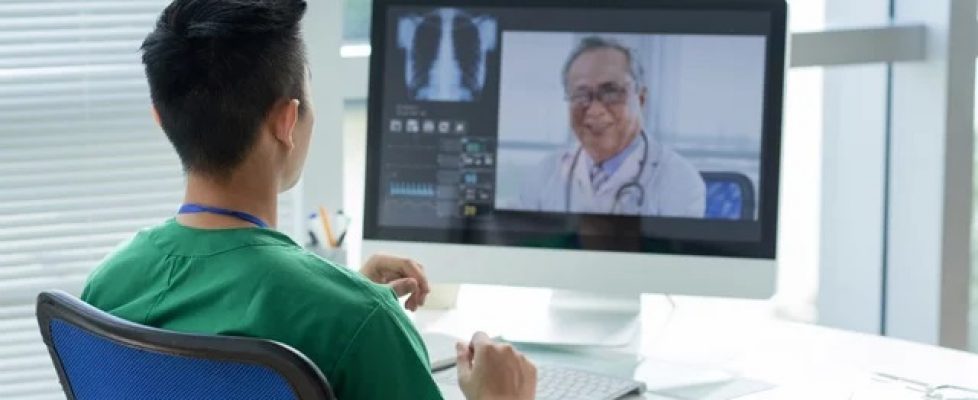5 More Takeaways About the Telehealth Boom
The second of a two-part story on 10 takeaways about the telehealth boom. The COVID-19 pandemic has been a bumpy ride in the U.S., featuring one controversy after another. One of the few areas of agreement is that the widespread adoption of telehealth amid the pandemic has been, by and large, a positive development.
The COVID-19 pandemic has been a bumpy ride in the United States, featuring one controversy after another. One of the few areas of agreement is that the widespread adoption of telehealth amid the pandemic has been, by and large, a positive development.
Here are the remaining 5 takeaways about the telehealth boom.
6. Telehealth has a role in inpatient care
Doctors attending to patients who are at home has fueled the COVID-19 telehealth boom, but telehealth is also playing a role in inpatient care. “During [the pandemic], we also found ways to implement telehealth among our inpatients in the hospital,” Pageler says. “This allowed physicians to care for patients in isolation while minimizing the spread of infection and conserving personal protective equipment, such as masks and gowns.”
Antall says many overwhelmed hospitals have had to “beam in” specialists from parts of the country with fewer COVID-19 cases. “We also saw telehealth as an important way for the ‘worried well’ to see a doctor from the comfort of their home so they didn’t have to take up critical space in emergency rooms if not necessary,” he says.
Northwell Health uses two telehealth platforms that involve some inpatient care, according to Berman: eICU, which utilizes Philips eCareManager software and consists of hardwired beds in ICUs that contain high-definition cameras, speakers, a monitor and a button that if pressed calls directly into a remote critical care team located in a command center that can supplement the bedside direct care team 24/7; and DTC (direct to consumer), which is being used for home televisits, clinic-to-clinic and consultations to the ER, and floor care of the hospitals.
7. Telehealth could widen, deepen the digital divide
Could the current go-go attitude about telehealth be going too far? There are some skeptics who argue that some nuanced information and connection is lost for lack of in-person care.
Emphasizing telehealth may deepen a digital divide that those with access to Wi-Fi, broadband, and fast, smart devices don’t experience and therefore may underestimate. According to the Federal Trade Commission, 19 million Americans lack access to fixed broadband service at threshold speeds, a problem much more acute in rural areas. Pew Research found that 19% of Americans do not own a smartphone. And there’s the irony that many of those without access to broadband or a smartphone are the very people who might benefit the most from telehealth because of access, mobility, and transportation issues.
“One trend we must be cautious of as this evolves is that we do not leave other at-risk populations behind—those who do not have adequate broadband coverage or access to devices either because of cost or location,” Berman says. “If we solve for that, we are on our way to a very new world of health care.”
8. Fraudsters see a telehealth opening — and take it
Almost every boom presents an opportunity for fraud, and the telehealth boom is no exception, In late September, the Justice Department announced it had charged 86 people with submitting $4.5 billion in fraudulent claims related to telemedicine. According to a press release about the charges, the defendants are accused of paying doctors and nurses to order unnecessary durable medical equipment, genetic and other kinds of diagnostic testing, and pain medication. The Justice Department press release also said that apart from the criminal cases, the CMS Center for Program Integrity had revoked the Medicare billing privileges of 256 medical professionals because of their involvement in telemedicine schemes.
9. State licensing requirements could become an obstacle
As the COVID-19 pandemic escalated in the spring and the demand for telehealth became apparent, many states moved to relax licensing rules that allowed healthcare professionals from other states to provide telehealth services. Those changes were another key ingredient in the telehealth boom recipe. But in some cases, the licensing rules were relaxed on a temporary basis and they might be tightened up if and when the COVID-19 pandemic eases up.
“For pediatric care especially, where specialists are often few and far between, we need to advocate for those state licensing changes to remain,” Pageler says.
10. Telehealth, in-person: Tis not an either/or
The course of the COVID-19 pandemic over the next several months is difficult to predict with any certainty. There are too many variables, including but not limited to the availability of a vaccine, adherence to social distancing and mask wearing, treatment advances, and the consequences of the election. But there has been resumption of some in-person care and indications that the demand for telehealth has slackened relative to the zenith in April and May when remote care was essentially the only option short of an outright emergency or absolute necessity.
“There are always going to be people who prefer to get their care in person, and there are always going to be some scenarios for which in-person care is better,” Antall says. His company believes in a hybrid-care model that offers support whether patients receive virtual or in-person care. “We want this to be a seamless experience,” Antall says.

